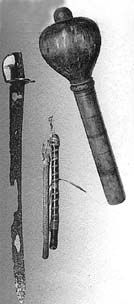Historical relics of the Bohdan Khmelnytsky period are expected to be delivered to Kyiv by charter flights from Sweden, Poland, and Russia in early March. The exposition will consist of the Hetman’s flag, mace as a symbol of office, saber, and two goblets. The return, albeit temporary, of the relics once in Khmelnytsky’s possession became possible thanks to the initiative of the Twenty-First Century Ukraine Intellectual Cooperation Foundation and long talks with foreign experts.
The historical treasures will be displayed first at the National History Museum and then at the Chyhyryn Historical and Cultural Preserve in Cherkasy oblast. According to People’s Deputy Bohdan Hubsky, chairman of the foundation, it is hard to overestimate the importance of the Hetman’s regalia visiting their homeland. At present, the only Khmelnytsky relic preserved in Ukraine is his hat, the rest of his personal effects are found in foreign museums. Thus, the Hetman’s flag, the most significant symbol of office ended at the Military Museum of Stockholm after the second Polish-Swedish war in the late seventeenth century and can be viewed now only by special permission of the Swedish queen. Khmelnytsky’s mace, made from a rhino horn encrusted with ivory and filled with silver, was in a Polish magnate’s private collection in the eighteenth century, later transferred to the Polish Army Museum; the whip and two goblets are at the National Museum of Krakow; a gold plate bearing the emblem of the Zaporozhzhian Host and the Hetman’s initials currently belongs to the State History Museum of Moscow.
Meanwhile there is nothing with which to fill the spacious premises of the Chyhyryn Museum, set up in 1994 in the Hetman’s honor, its staff members say. For want of truly spectacular items on display, the museum has lost its thematic orientation, turning into a curiosity shop of sorts, where enthusiastic staff employees bring everything antique they can get hold of in the course of archaeological diggings in the vicinity of Chyhyryn. Perhaps the only interesting items are the portraits of Ukrainian hetmans by the Ukrainian master Danylo Narbut, a portrait of Khmelnytsky by an anonymous seventeenth century artist, and ten etchings (portraits of Zaporozhzhian military leaders and battle scenes) by Oleksandr Danchenko. Incidentally, the museum received the etchings late last year, also courtesy of Twenty-First Century Ukraine. Mr. Hubsky says the foundation will make every effort, given state support, to return the Hetman’s relics to their native land.







